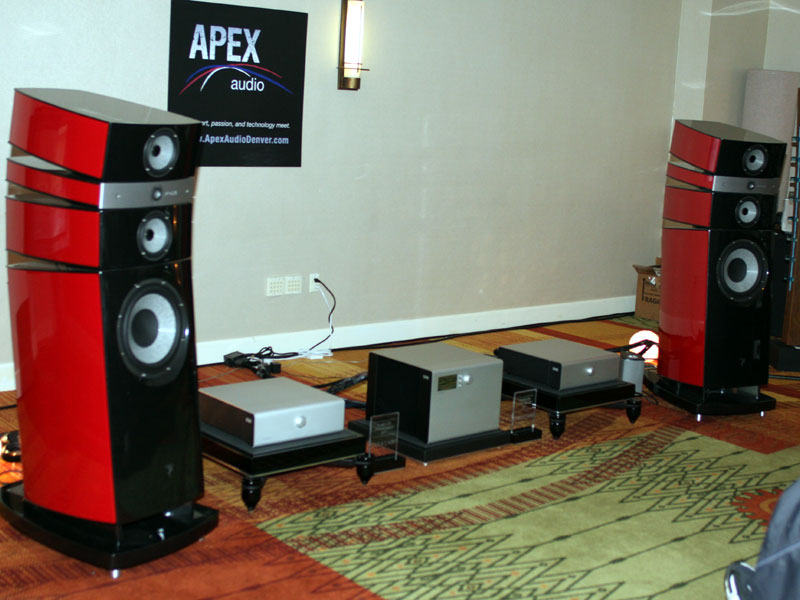Rocky Mountain Audio Fest 2013 • Dancing on a Volcano
othing is as certain as death and taxes, except, that is, the propensity of the hi-fi industry, its dealers and customers to clutch at each new format or technological fashion with the desperate abandon of a drowning man seizing whatever comes to hand -- without stopping to consider whether that object will keep him afloat or drag him under. This lemming-like attitude to self-preservation has seen the premature abandonment of one technology after another; as soon as the initial gloss wears off, it’s on to the next new thing. The ever-spinning wheel of competing output topologies is but one example; the widely announced "death" of optical-disc replay is another far more serious one. Show sound might be at best a variable commodity, but RMAF 2013 -- surely now accepted as the premier two-channel show in the continental US -- should serve as a timely reminder of history’s lessons for any audiophile who cares to listen. According to many of the most established pundits and respected manufacturers, file replay systems are not just the de facto reality of the audio future, they’re the only one they are interested in talking about -- or selling. Yet the undignified scramble to clamber aboard the high-res gravy train has raised far more questions than it has provided answers. Not only are many of the replay platforms worryingly unstable (and enigmatic when it comes to their operating status) the flood of supposedly high-res material onto an uninformed and ill-prepared market has left many a consumer with egg not just on his face, but dribbling down the front of his cloak of audiophile office. The elephant in this particular room is the (un)availability of native high-res files that offer anything other than spectacular sonics -- and let’s be honest, there was a veritable herd of elephants at RMAF. Once you get past the modern equivalent of a train steaming from left to right across your listening room, where’s the music you might actually want to hear? The vast majority of systems in Denver this year offered some form of file replay system -- and in many cases nothing else. Yet for anybody with an open mind -- and equally open ears -- not one was actually delivering on the promise of high-res file replay. They could chop and change tracks with abandon, shuffling a waterfall of options, cascading down an iPad screen, but where was the performance? In a nicely ironic twist, where high-res files did deliver it was generally with material originally recorded on analog tape. For musical integrity, for the sense of real people playing real instruments, it was the older, more mature and now supposedly defunct (or should that be de-funked) formats that really delivered the goods. With a brief to seek out the best-sounding rooms at the show, system performance rather than individual products are the order of the day. Indeed, you can only listen to a system, making the notion of individual product assessment (always a problematic concept) all but impossible under show conditions. The classic audiophile comment, "Oh, I heard that amp [or CD player, preamp, turntable, or speaker] at a show and it was fantastic [or terrible]!" is perhaps understandable amongst those for whom shows are the only opportunity to hear much of this equipment. But that doesn’t make it any more meaningful -- and reviewers in particular really should know better. With a full program of seminars to conduct, time was of the essence, so rooms needed to be working and working well in order to attract my attention. There are few second chances when time is pressing and the corridors stretch ever onwards. So, which systems really lit my candle? Let’s start with two companies whose products featured in my speaker-setup seminar system. (Coverage of the seminar and a set of detailed instructions covering the techniques demonstrated will be posted as soon as the seminars at TAVES have been completed.)
The irrepressible Greg Roberts of Volti Audio was driving his distinctly retro and impressively affordable horn speakers with amplification from the BorderPatrol range of ex-patriot Yorkshireman Gary Dews. You can take the man out of Yorkshire but you can’t take the Yorkshire out of the man, and with the sardonic asides of Mr. Dews offering the perfect foil for the unabashed enthusiasm of the Volti-maester of ceremonies, this was one of the most entertaining double acts at the show. And the system was pretty good too! The three-way Vittora horns ($17,500/pair) and Vittora subwoofer ($2900 plus $1500 for the driving amp, a Marchand MB42) were being driven with impressive effect by the BorderPatrol S20 EXD parallel single-ended 300B amplifier, complete with a pair of massive EXS external power supplies. The EXD suffix indicates the use of copper chassis parts, upgraded components and cryo-treated interstage and output transformers, and with a pair of stock MB power supplies it would set you back $16,750. The EXS power supplies are a new and far larger version of BorderPatrol’s existing external units, the new design weighing in at 80 pounds apiece. Each copper chassis houses a pair of mains transformers, an up-rated HT choke and three independent, tube-rectified outputs, each with its own dedicated choke input filter. Extensive cryo treatment is employed throughout, the pair of EXS power supplies raising the total cost of the three-chassis amplifier to $25,750. The line stage was the BorderPatrol EXT1, used with a single EXT power supply ($12,250 -- although a second supply can be added for an extra $3000). The source was the BorderPatrol DAC2, a filter-less, non-oversampling design with a 6SN7 tube output stage and a timber housing (the word "wooden" doesn't really do it justice) that will set you back $9750. An elderly TentLabs CD player, originally a DIY modification based on a Philips CD-Pro transport with upgraded supplies and clock, supplied the signal. The Volti speakers are a fully horn-loaded design with a 15" bass driver built into a curved-wall, folded-horn cabinet constructed from 1" Baltic birch ply. The separate mid/treble enclosure contains a 2" compression driver loaded by Volti’s own wooden tractrix horn and a 1" compression driver, also tractrix loaded for the treble. Painstakingly hand-built in Maine on a cost-plus basis, this is a huge amount of speaker for your money -- in both physical and musical terms. The matching sub, with matching curved-wall enclosure, contains a downward-firing 18" unit, and together the five Vittora boxes deliver a system sensitivity of 104dB across the audio bandwidth. The lack of dealer /distributor margins means that the pricing of the Volti products is in no way comparable with other equivalent designs -- although that is something of a double-edged sword. The (comparatively) affordable costs make this a huge bargain, but for some listeners, the low price might call the system’s quality into question. It shouldn’t. With over $6000 worth of parts and 200 man-hours invested in each pair, conventional pricing would place these speakers around the $60,000 mark -- and they’d still hold their own!
The BorderPatrol units are also unusual. Their split-chassis design and massive choke-regulated supplies are an approach more generally associated with exotic and pricey imports from the Far East, yet their sound is all about the 300B’s linearity coupled to extended bandwidth, drive and control. There’s none of the exaggerated, lush midband warmth normally associated with 300B designs -- just natural color, presence and dynamics, underpinned by bass that can really kick. The prices aren’t quite in the same bargain category as Volti’s (whose are?), but just examine the material and engineering content when compared with the competition. Then look at the comparative prices and I think you’ll find that the BorderPatrol products deliver an awful lot of amplifier for the money. The whole system sat on slab-sided tables built from 2" Baltic birch ply and in-house veneered by Volti, their understated appearance downplaying the quality of the materials and workmanship involved. As the dour Mr. Dews was heard to comment (assume Yorkshire accent) "Ah told yew, yew should have left the plies shewing!" Electronics were laced together with a mash up of cables best described as "What I had at home" -- down to a UK 13A pattern AC distribution block. This typically no-nonsense approach delivered one of the most effortlessly involving and entertaining sounds at the show -- reflected by the fact that the room seemed to be permanently packed. The easy dynamics and scale that any good horn system should deliver were accompanied by a surprisingly coherent soundfield, great top-to-bottom continuity and a refreshing lack of intrusive coloration. Despite the large cabinets and small room, this was a system that brought a smile to the face and got the feet tapping. It really allowed music to breathe, vocals being especially impressive, while jazz could (almost literally) blow you away. Yes, it would go loud, but it would also play almost anything with sufficient refinement and the sort of poise that could cause traditional horn haters to question their eyes, their ears or their prejudices. There was a "Sold" sticker on the show speakers by the end of day one, and I’m really not surprised. Score one for the horns, one for private enterprise and another for SETs that sound like real amps and real music. And while you are about it, let’s score one for CD too. On that subject, First Impression Music have been remastering Red Book CDs to impressive effect for several years and I used their We Get Requests reissue (Oscar Peterson Trio [LIM K2 HD 032]) as the musical benchmark for the seminar sessions. This is by far the best non-vinyl version of this audiophile standard I’ve yet come across, an example of FIM’s 99.9999% silver data-layer disc technology, an approach that yields consistently superior results. Until now, that is. Entering the FIM room in search of new silver-disc goodies I was duly informed that six-nines silver was no longer the order of the day, replaced by the new PureFlection Ultra HD series. According to FIM, this new disc-manufacturing process employs a Blu-ray cutter to manually create a glass master, in a fashion more similar to cutting a vinyl disc than the automated process generally used to transfer digital data. This allows precise control of the pitch of the pit groove, as well as the spacing and profile between pits, resulting in measurable improvements in multiple technical parameters of disc performance, but most notably block error rate and disc-induced jitter. Indeed, the company reproduces the technical parameters and compliance certificate for each and every disc in the series, reprinting it inside the disc booklet. Okay, we don’t have similar data for other discs of the same performance, but ultimately the proof of this pudding is in the listening, and the two discs I bought (The Best Of Play Bach, Jacques Loussier Trio [Telarc/LIM UHD 067] and the Telarc Carmina Burana (Shaw/Atlanta Symphony and Chorus [Telarc/LIM UHD 073]) both exhibit stunning sound quality, with a delicacy, a musical, spatial and dynamic coherence and sense of easy, expressive flow -- especially in the Jacques Loussier disc -- that escape all but the very best digital replay systems. Interestingly, with one of the original recordings being analog and the other Soundstream digital, the results are remarkably consistent. FIM make it clear that although they are able to employ anything up to 32-bit/192kHz in converting original masters, a higher bit rate does not always produce the most musically engaging results, requiring a careful balancing of resolution and musical qualities. They also go to great lengths to ensure that they respect the sampling rate of original digital tapes. Whilst I’m ill-equipped to comment on FIM’s technical claims, the sonic results are hard to argue with -- even if they are encoded on lowly Red Book CDs! Get ‘em while you still can -- before the onrushing hordes of file-replay fundamentalists sweep them aside.
On the subject of software, the other really exciting introduction came from MA Recordings, in the shape of their new synthetic LP inner sleeves. Okay, I acknowledge that getting excited about a blank white square of fibrous but otherwise featureless material is pretty sad, but with quality inner sleeves so critical to the preservation of vinyl discs, this is a welcome introduction indeed. At $30 for 50 sleeves (plus postage), these were being lovingly fondled by not just me but Messers Mickelson and Davis too. When three middle-aged men stand around cooing over something this prosaic you just know that it is that special sort of weird to make grown record collectors go all weak at the knees.
One other product that I just have to flag is PS Audio’s NuWave phono converter ($1895), a small but surprisingly heavy box that combines a standard line-level analog input and a fully configurable RIAA moving-coil input with a choice of analog or digital outputs. The perfect solution for those wanting to archive/rip LPs (or other analog sources) to server-based file-replay systems or simply incorporate an analog source into a system built around one of the growing number of increasingly capable digital control units (basically DACs with switchable inputs and a variable analog output), this is a refreshingly clear-sighted initiative from a company with a reputation for products that are both affordable and ahead of the curve. Capable of outputting both 24-bit/192kHz PCM or 64x/double DSD at 128x oversampled rates via S/PDIF, I²S or USB, it seems to have all the DAC and computer-audio bases covered, which is especially impressive given its price. If the audio performance matches the innovation, then this should answer more than a few audiophile prayers. With a review sample due shortly, that’s a question that I should be able to answer pretty soon.
Moving on, we come to what I thought were the three most consistently enjoyable rooms at the show. I took the time to revisit each on several occasions and was more and more impressed as the show wore on (and the systems settled down). First up (and in no particular order) was the VTL room, running a seriously ambitious setup that should (and did) impress. Built around a core of VTL’s TP-6.5 Signature Series II phono stage with step-up option ($10,500), TL-7.5 Series III line stage ($20,000) and the new S-400 Series II power amp ($33,500), the system featured a Spiral Groove SG 1.1/Centroid ($37,995) and four-box dCS Paganini ($55,500) front-ends, with Wilson Alexias ($48,500/pair) delivering the music. Cables were a mix of Nordost Odin and Valhalla for AC, and Odin for digital interconnects and clock cables. A 2.5-meter Odin AC lead will set you back $16,000, with the original Valhalla power cords weighing in at $3000 each. If you think that’s expensive, Odin digital leads are $10,000 each; now count how many interconnects and clock cables you need to lace the dCS four-box setup together. Analog interconnects and speaker cables were Transparent Audio Opus MM2 with a combined total price of $108,625. Add that lot up and the numbers get pretty frightening pretty quickly! The racks were a finite elemente HD-04 for the tube electronics and turntable, with a HiEnd Racks Studio Reference for the dCS rig. This was a new product to me. Hailing from Mexico, it involves sandwich shelves and multiple constrained-damping layers and soft interfaces in a usefully versatile arrangement. But the real star of this show -- or at least the thing that was getting Bea Lam all hot and bothered -- was the brand-new, just-delivered Lyra Etna cartridge ($6995). One of just three production examples at the show, hand-delivered by Stig (or should that be Stork) Bjorg, this new model, first glimpsed at the Munich show, promised a lot and seems to deliver even more. Having heard what it could do, Bea was so smitten that rumor has it that husband Luke was made to sleep behind the demo-room door in order to prevent jealous rivals making off with her new needle. Only joking -- but only just. Interestingly, aside from the S-400 II and Etna, the record replay chain in this system was virtually identical to last year, allowing at least some sort of basis for comparison. Playing the Maazel/VPO Sibelius 2 on Decca [SXL6125] -- a second pressing, UK narrow band, abducted by Luke Manley from Notting Hill Tape and Record Exchange moments before I reached it -- the sound was sweet and open yet substantial and impressively dynamic. The majestic sweep of this most evocative of symphonies was beautifully captured, its towering crescendos scaled with ease (which speaks well of the S-400 II’s control and headroom), yet the performance was both spatially coherent and full of delicate textures and nuance. Pacing was unforced, but there was no doubting the incisive nature of the orchestral direction. If the mark of a great system is that it lets you hear the conductor, then this was great indeed. The new S-400 Series II has been revised to bring it into line with other recent VTL power amps (the MB-450 III and Siegfried II) with a new fully balanced, differential input stage, a new phase-splitter circuit, lower-impedance output stage and balanced, interleaved output transformer. The negative feedback is now also fully balanced, with a shorter path and zero global feedback. The circuit is unconditionally stable and its ability to remain musically solid and unflustered under the most musically demanding circumstances was mightily impressive. Just witness the astonishing weight, power, presence and complexity this system brought to the Cadenza of the Arturo Benedetti Michelangeli performance of Beethoven’s First Piano Concerto [DGG 2531 302]. Yet, at the same time, the delicacy and immaculate weighting of the quieter passages were captivating, once again making me wonder how this man, with hands like shovels and the wingspan of a Pyrenean condor, can play with such grace. Likewise, if the ability to mix lightness of touch with real musical authority is one of the greatest challenges facing any amp designer, then Luke Manley appears to have a real winner on his hands. Recently I’ve preferred the MB-450 III to the more expensive S-400, but maybe that is due to change. There’s no doubting the sheer quality of the vinyl front-end in this system, the part played by the Etna in that equation, but the amps and speakers need to be able to respond to that signal and in this system they did -- with gusto.
Next up, another tube-based system, this time from Fort Collins dealer The Audio Alternative, which put together a system consisting of an Audio Research Reference Phono 10 phono stage ($30,000), Reference 10 line stage ($30,000) and a pair of Reference 150 stereo amps ($13,000 each), biamping Vandersteen Model 7 loudspeakers ($45,000/pair). Sources were a Reference 9 CD player/DAC ($13,000) and an AMG Viella 12 turntable and tonearm ($16,500) carrying -- you guessed it -- another Lyra Etna ($6995). Harmonic Resolution Systems equipment supports were used throughout: SXR stands with R1X isolation bases for the source and preamplification components ($6100 for each four-component frame, $1395 for each isolation shelf, price varying with size) and M3X isolation bases for the amps (around $2750 each, depending on size). Cabling was all from AudioQuest, with Wild Blue Yonder interconnects ($8900/meter pair), Wildwood speaker cables ($7400 for a three-meter pair) and NRG power cords ($3500 for 1.8-meter length). As someone who bangs on and on about coherent approaches to system support and cabling, this setup was (quite literally) music to my ears. Again, there were similarities with last year, although not nearly so many as in the VTL system. Audio Research's traditional expansive soundstage was all present and correct, but this system had a dynamic suppleness, a way with the subtleties in a performance as well as the ability to get really big really fast, that made it engaging and impressive in equal measure. It might have lacked the absolute dynamic authority of the VTL rig, but its warmer midhall perspective and balance would certainly suit some listeners more. What really demonstrated its quality for me was its stability and ability to separate loud and quiet sounds, holding each stable in space. The castanets of the familiar EMI Studio 2 stereo disc of Massenet’s Le Cid ballet music (Louis Fremaux and the City of Birmingham Symphony Orchestra [TWO 350]) were locked in space and perfectly scaled, the system resisting any tendency to over excitement, perfectly maintaining the contrast between quiet contribution and sudden orchestral response. I might be speculating, but I can’t help pointing a finger at the biamped arrangement as at least partly responsible for this dynamic coherence and smooth, expressive quality. This is a recording that demands a lot and gets ragged real quick if it doesn’t get what it wants. The sheer grace with which the electronics were able to respond made this a great system to spend time with and seriously increases my desire to spend time with the new Audio Research Reference products. With the aforementioned Mickelson and Davis ahead of me in the line, it looks like I might have to rely on UK connections to access this US product; as my old mate David says, "Same as it ever was -- same as it e-v-e-r w-a-s." Meanwhile, the Vandersteen Model 7s must surely be the most underrated high-end speakers out there. I’ve heard them sounding so good on so many different occasions and in so many disparate locations that they too seriously pique my interest -- and what price the budget version of this technology, the Quatro? Finally, do I think the presence of the Lyra Etna at the pointy end of proceedings in a system sounding as good as this is a coincidence? No, I don’t.
Third up was another vinyl-driven super system, featuring a Clearaudio analog front-end, Aesthetix electronics and the new Focal Scala Utopia V2 speakers ($32,500/pair), which will be arriving chez Gregory for review in early November. They feature major revisions to the bass driver’s spider and motor, designed to deliver greater control, linearity and out-of-band behavior, along with subtle changes to the cabinet to improve dispersion. The improvement in dynamics and bass definition extend well up into the 800-1000Hz range (according to Focal) allowing further revoicing of the midband and a subsequent increase in focus, dimensionality and immediacy. If their performance at RMAF is anything to go by, I’ll certainly be enjoying their visit. Mind you, the driving system probably had more than just a little to do with it. The turntable was the new Clearaudio Master Innovation ($25,000), with magnetically opposed bearing and zero-contact drive system, integral Everest stand ($12,000), Statement and Outer Limit clamps ($2350 the pair) and AccuDrive battery power supply ($2500). That sported a Graham Phantom II Supreme 10" tonearm ($7000) carrying a Clearaudio Goldfinger Statement cartridge ($15,000). Yup -- that’s a cool $63,850 for the record player. Against that, the Aesthetix Io Eclipse phono stage ($15,500), Callisto Eclipse remote-controlled line stage ($19,500) and Atlas mono power amps ($16,000/pair) look almost bargain-basement priced -- especially those amps, which I remember with a mixture of affection and awe, verging on trepidation from their last visit to my listening room, where their combination of sheer musical enthusiasm and unburstable power delivery left me quaking in their path on more than one occasion. If you want classy and loud, these are the biggest bargain on the block! Sit the electronics on Critical Mass Soto Voce racks ($4500 each) and lace the whole lot together with a nice, coherent cable loom and you are onto a winner. In this case, the cables of choice were Nordost’s remarkable new Valhalla 2, complete with the QRT power distribution system. At $7600 for a meter pair of interconnects, $14,850 for three-meter speaker cables and $6000 for a two-meter power cord, V2 is a long way from cheap, but it will run you a lot less than a full Odin setup. More interestingly, it also marks the introduction of Nordost’s first in-house connector designs. Everything suggests that connectors are the next big obstacle to be overcome in cable performance, a proposition that is underlined by the sound of the V2. With its remarkably complete presentation, natural balance and unforced yet expressive dynamics, it represents a whole new level of performance and communication for the Nordost line. Which rather raises the question, how long will it be before those connectors find their way onto Odin -- and what will that reveal? Playing the Analogue Productions 200-gram pressing of Janis Ian’s Breaking Silence [LAP0027] amply demonstrated this system’s speed and dynamic authority, with this legendary all-analog recording delivered in all its glory. But it was when we played the quieter, straight-to-two-track, voice-and-piano arrangement of "Some People’s Lives" that the transparency, focus, natural timbres and sheer microdynamic intimacy of this record and this system combined to produce something really quite magical. The piano was big and stable, yet the careful weighting of each note, the spaces between them and the shaping of the phrases was clear, lucid and natural, providing the perfect foil for Ian’s affecting vocals. Rarely has a slow song sounded so free of system constraints, able to set its own measure, to breathe and proceed at its own pace. Any system with the Atlas monos in it will go loud, but this was a stunning illustration of their capabilities at the other end of the scale, their ability to use every last ounce of subtlety squeezed out of those grooves by the Goldfinger Statement and preserved by the Io phono and line stages. All three of these systems were exceptional, all three paid serious attention to providing coherent support and cable strategies, and all three featured superb electronics and highly respected speakers, but I can’t help feeling that what really set them apart was the sheer quality of the cartridges traversing those grooves. I know the Goldfinger Statement only too well, it being my needle of choice in my own system, but the Lyra Etna sounds awfully special -- especially at less than half the price of the German unit. The RMAF has always had a healthy analog presence and this year was no different, but if there were fewer ‘tables on show, they were being used to better effect. There’s nothing like a little competition (let alone impending obsolescence) to raise the bar and sharpen the responses. With CD also showing signs of resurgence, maybe it’s time to slow up on the computer-audio front, take our time and get it right, rather than simply be swept off the cliff in a tide of hasty and ill-considered enthusiasm. There were file-replay systems on show that demonstrated promise, and a few files to play on them that delivered stunning (if commercially unavailable) results. Jeff Rowland’s Aeris DAC ($9800) and the new Continuum Series II integrated amp (from $9500), playing through Raidho D1s ($28,500/pair including stands) was a case in point, but the wonderful Branford Marsalis track in question was a live concert recording with no plans for immediate release. Looking back at RMAF 2013, it is those three analog-fronted, tube-powered systems that I’ll remember most fondly, each with its own blend of virtues and special appeal. First amongst equals? No system as such, but the Lyra Etna seems certain to haunt my dreams -- at least until I manage to get a hold of one! And now it’s time to Duck For Cover
At a cool quarter of a million, plus racks and cables that don’t come cheap, that is quite a price tag. Sadly, like so many over-priced footballers, it totally failed to deliver. Like them, it seemed stultifyingly constricted and unable to perform. Rarely have I heard a system sound so sterile, dynamically flat and expressively constipated, every last vestige of musicality sacrificed on the alter of transparency and focus. This was so dry, so immobile, so colorless, so positively statuesque that tracks took on an almost photographic quality -- just like a black-and-white still shot on fine-grain stock. There may be no magic in the Magicos, but the observation that there’s no soul in the Soulution might just go down in history as the audio understatement of the year. Having recently suffered another system that combined the smaller Soulution electronics with Maestro Utopias at the National Audio Show in the UK, I know that this is not an isolated example, but this iteration took things to a new low. Devoid of life or musicality, this system seemed to suck the very air from the room (although that could have been the altitude, I suppose). Stay too long and I couldn’t help the feeling that, like Lot’s wife, you’d be turned into a pillar of salt.
But what made this system’s shortcomings so apparent
was the presence four doors down of the Clearaudio/Aesthetix/Scala system being
demonstrated to such excellent effect. Total up the boxes and that runs out around
$100,000 less! It spends a little more on cables, a little less on racks, but the bottom
line is the same: The pint-sized Scala V2 stomped on the three-times-the-price Stella,
unceremoniously and enthusiastically. Now, I know both speakers and I’m telling you
that under normal circumstance, and not surprisingly, that’s not the result I’d
anticipate. Which just goes to prove, if proof were needed, how unreliable conclusions
drawn at shows really are. You pays your money, you tramp the corridors and visit the
rooms, but there really is no accounting for some of the systems on show. |

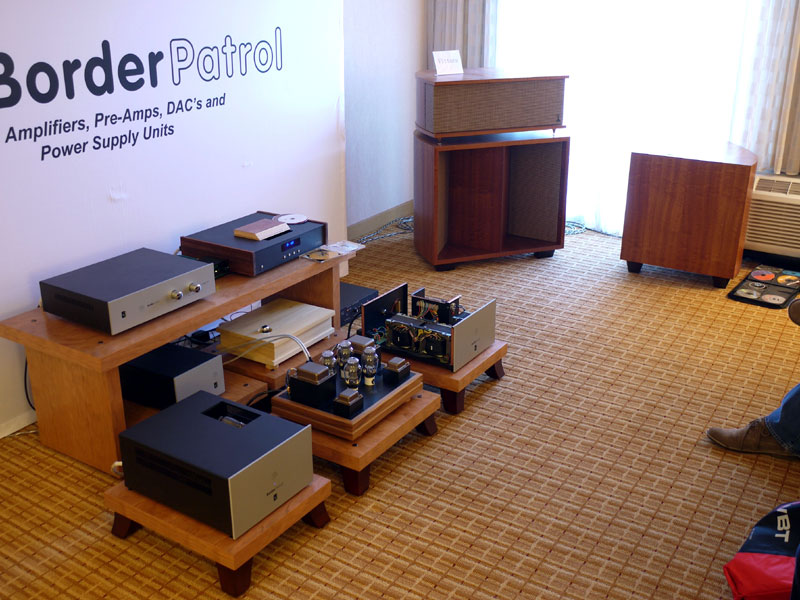
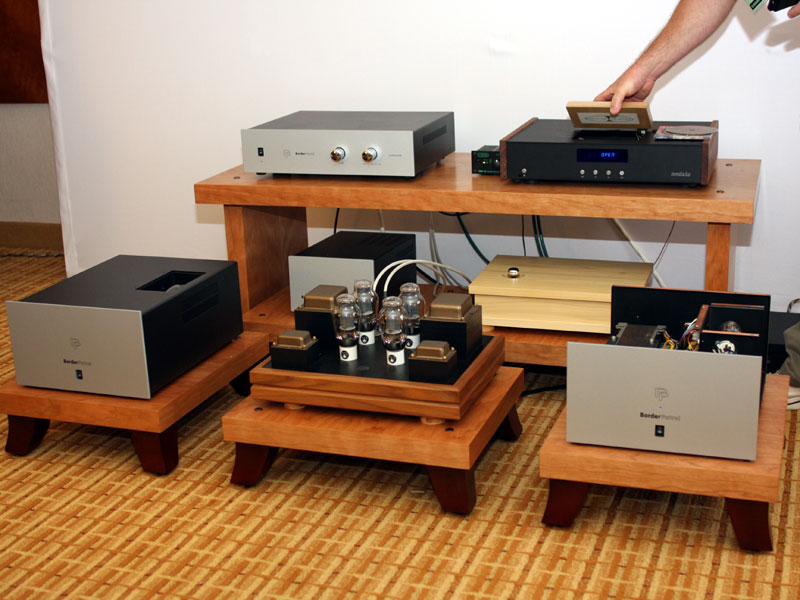
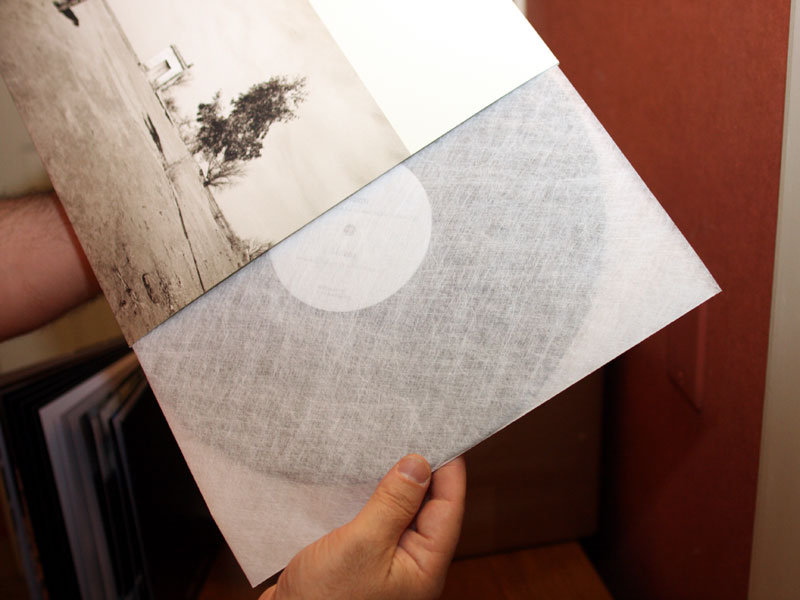
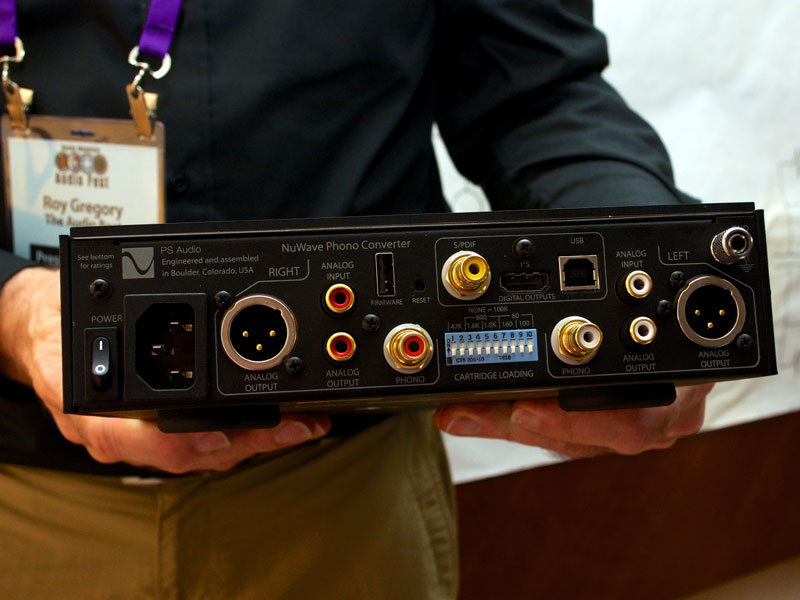
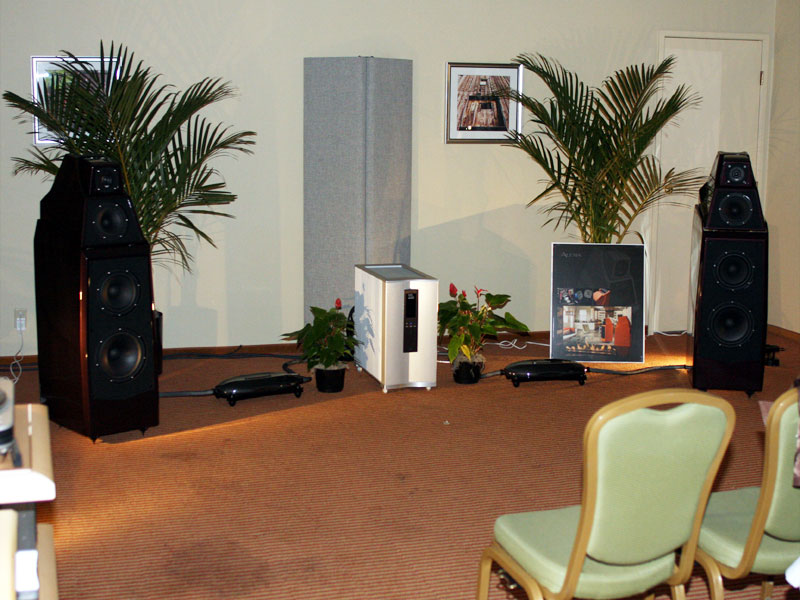
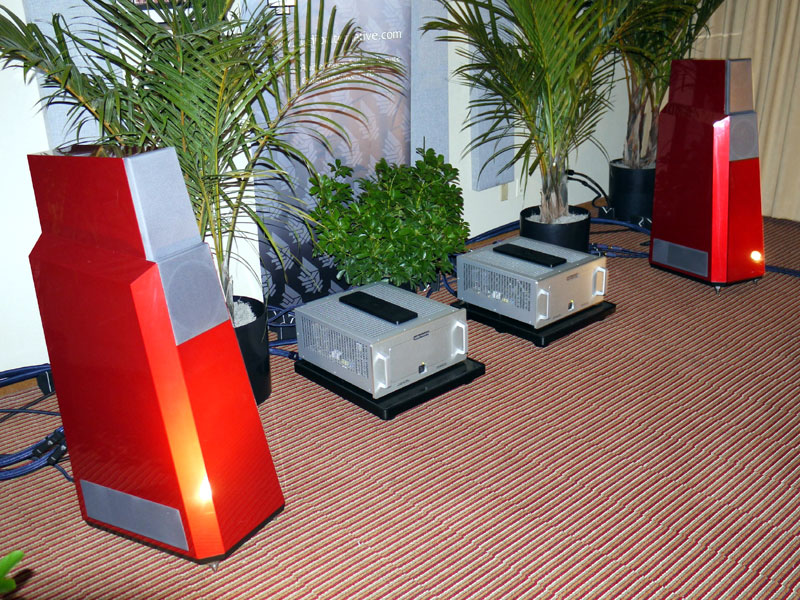
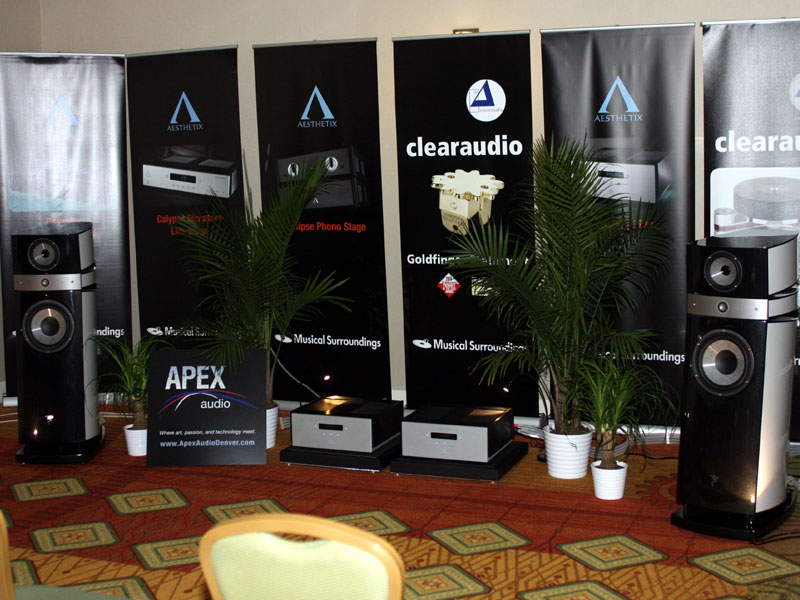
 Normally this award tends
to reside with those exhibitors and systems that almost literally fire musical notes in
your direction, perhaps giving horn speakers an unfair advantage. However, at RMAF 2013,
our winner is a cat of quite a different color. In the Blanca Peak room, Apex
Audio mated Focal’s Stella Utopia EM loudspeakers
($95,000/pair) with $114,000 worth of Soulution electronics: 540 CD/SACD
player, 520 preamp and 500 monoblocks. The turntable was the Transrotor
Rondino Nero ($14,000) mounted with a Graham Phantom II Supreme tonearm
($7000) and an Air Tight PC-1 Supreme cartridge ($10,500), all fed from a
Running Springs Audio Nikolai Reference power conditioner ($8000) and
stood on Critical Mass Systems MAXXUM racks costing $5650 per level.
Cabling was Tara Labs Zero Gold interconnects, Zero Gold speaker cables
and Cobalt power cords.
Normally this award tends
to reside with those exhibitors and systems that almost literally fire musical notes in
your direction, perhaps giving horn speakers an unfair advantage. However, at RMAF 2013,
our winner is a cat of quite a different color. In the Blanca Peak room, Apex
Audio mated Focal’s Stella Utopia EM loudspeakers
($95,000/pair) with $114,000 worth of Soulution electronics: 540 CD/SACD
player, 520 preamp and 500 monoblocks. The turntable was the Transrotor
Rondino Nero ($14,000) mounted with a Graham Phantom II Supreme tonearm
($7000) and an Air Tight PC-1 Supreme cartridge ($10,500), all fed from a
Running Springs Audio Nikolai Reference power conditioner ($8000) and
stood on Critical Mass Systems MAXXUM racks costing $5650 per level.
Cabling was Tara Labs Zero Gold interconnects, Zero Gold speaker cables
and Cobalt power cords.